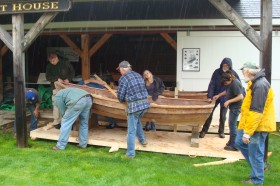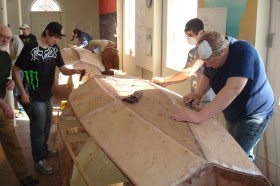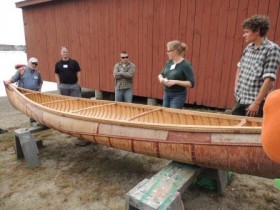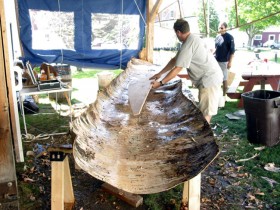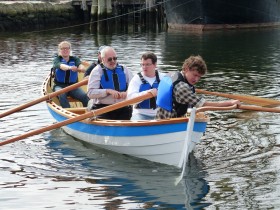The Penobscot Marine Museum is reaching out to those students failing in the traditional classroom. Studies of information retention put reading and verbal instruction as the least effective way of retaining information, yet that is how we teach in traditional classroom settings. Museums with their exhibits and living history demonstrations where students can hear and see the information has a 50% retention rate. The highest rate of retention is actually doing a task. The Penobscot Marine Museum has partnered with the Searsport District High School and local boat-builder Greg Rössel in developing a hands-on science and math curriculum geared for optimum retention. The SDHS teachers have developed science and math curriculum tied to building the Shellback dinghy. A select group of SDHS students during the spring semester take a class at the Penobscot Marine Museum with Greg Rössel. While few of the students will pursue a career in boatbuilding, they come away with an understanding of trigonometry, physics, algebra, geometry and their own skills. Wanting to know more and connect with similar programs, the Museum sent me as a representative of this partnership to the Teaching with Small Boats Alliance conference.
The Teaching with Small Boats Alliance (TWSBA) is a network of maritime schools, boat-building shops, museums and community groups whose vision is to give young people an awareness of and resulting pride in their learning through the hands-on study of the maritime arts, its history and its relationship to success in math and science. TWSBA’s mission is to improve the effectiveness of these organizations through a sharing of ‘best practices’ that promote the values of scholarship, craftsmanship, ingenuity, self-discipline and a true sense of accomplishment. The conference this year focused on organizational development, program development and curriculum development. It is all too easy to feel isolated when pursuing non-traditional models in schools and museums; it is such a relief to meet with sister institutions from across the United States that have implemented similar programs and who are willing to share their successes and failures. There is no need to reinvent the wheel when so many are willing to share their resources. There were sessions on the nitty-gritty issues of insurance, fundraising, human relations, and leadership which, while not that fun, are necessary to fulfill our programmatic mission to inspire, educate and recreate. Other sessions discussed how to get passionate adult volunteers to provide necessary, but otherwise costly, assistance in the boat shop and providing one-on-one tutorials in boat-building with the students. Representatives from the United States’ nineteen maritime primary and high schools provided insights in how to “marinize” the Common Core standards, reflecting how the sea connects all things and all subjects. Our location on Penobscot Bay provides students with an open-air classroom in history, biology, chemistry, physics, mathematics, etc.
Of course all talk and no hands-on activities is an anathema to this group. I brought down the Passamaquoddy ocean-going canoe built by members of the Penobscot and Western Abenaki nations during the summer of 2006 on the Museum grounds. Between 2005 and 2010, native apprentices learned the art of birchbark canoe-building on our campus and demonstrated the process to our visitors. The canoe was a project of note in the Indigenous Programs presentation at the TWSBA conference. Attendees spent three afternoons admiring their workmanship and taking it out for a paddle in the Mystic River. In addition to paddling our canoe, I took a row in the four-man St. Ayles Skiff and one-man Bevin’s Skiff built by other student organizations.
I returned from the conference inspired to do more hands-on learning projects. If you are interested in this way of learning, please visit the Teaching With Small Boats Alliance website at https://sites.google.com/site/twsballaince/ . Once you too are inspired, contact the Museum about volunteering with our area students at 207-548-2529 or [email protected] .

